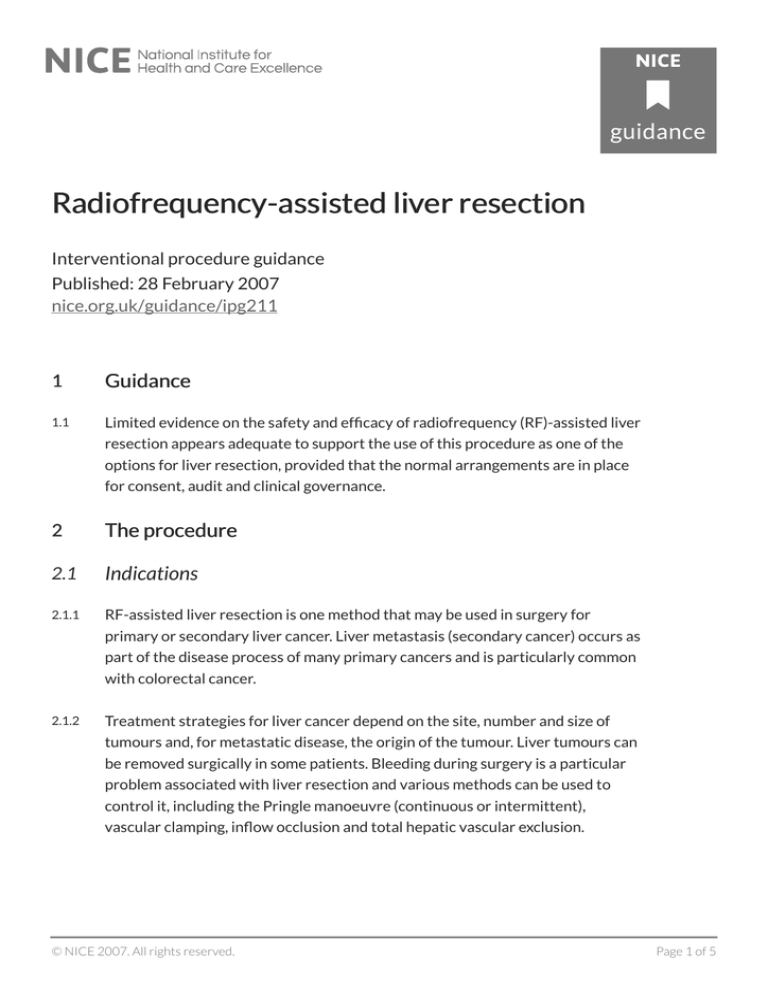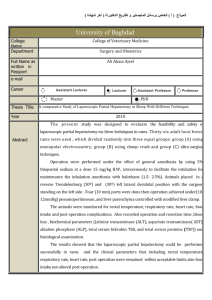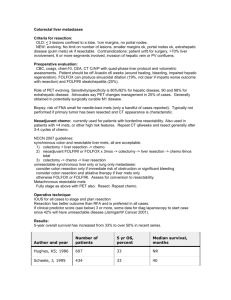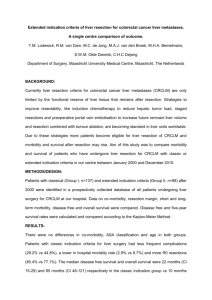
Radiofrequency-assisted liv
liver
er resection
Interventional procedure guidance
Published: 28 February 2007
nice.org.uk/guidance/ipg211
1
Guidance
1.1
Limited evidence on the safety and efficacy of radiofrequency (RF)-assisted liver
resection appears adequate to support the use of this procedure as one of the
options for liver resection, provided that the normal arrangements are in place
for consent, audit and clinical governance.
2
The procedure
2.1
Indications
2.1.1
RF-assisted liver resection is one method that may be used in surgery for
primary or secondary liver cancer. Liver metastasis (secondary cancer) occurs as
part of the disease process of many primary cancers and is particularly common
with colorectal cancer.
2.1.2
Treatment strategies for liver cancer depend on the site, number and size of
tumours and, for metastatic disease, the origin of the tumour. Liver tumours can
be removed surgically in some patients. Bleeding during surgery is a particular
problem associated with liver resection and various methods can be used to
control it, including the Pringle manoeuvre (continuous or intermittent),
vascular clamping, inflow occlusion and total hepatic vascular exclusion.
© NICE 2007. All rights reserved.
Page 1 of 5
Radiofrequency-assisted liver resection (IPG211)
2.2
Outline of the procedure
2.2.1
The aim of RF-assisted liver resection is to transect the liver with minimal blood
loss. The procedure is usually performed under general anaesthesia using
ultrasound guidance. The capsule of the liver is scored and a line of dissection
marked at an appropriate distance from the tumour. Ablation of liver
parenchyma is then achieved using an RF probe, applied repeatedly until a
sufficient depth of coagulation is achieved. The liver is then resected along the
line of necrosed tissue, using a scalpel, scissors, electrocautery or forceps. A
number of devices can be used to perform RF-assisted resection.
2.3
Efficacy
2.3.1
A randomised controlled trial comparing RF-assisted liver resection (n = 40)
with a clamp crushing method (n = 40) found no significant difference in total
blood loss during the procedure: mean blood losses were 665 ml and 733 ml,
respectively (p = 0.450). The mean transection time was 79 minutes with RFassisted resection and 80 minutes with clamp crushing (p = 0.740). The mean
length of hospital stay was 16 days and 18 days, respectively (p = 0.941).
2.3.2
In a non-randomised controlled trial and four case series, mean operative blood
loss during RF-assisted liver resection was 30 ml (in two studies), 46 ml, 100 ml
and 120 ml. Across these same studies, the mean operative time was between
90 and 220 minutes, although operative techniques differed between studies.
2.3.3
A case series of 15 patients undergoing RF-assisted liver resection for
secondary lesions, followed up for a mean of 7 months (range 2–20 months),
reported that there was no local recurrence of liver tumours on either imaging
or clinical examination. For more details, refer to the 'Sources of evidence'
section.
2.3.4
The Specialist Advisers stated that reducing blood loss is a key outcome
measure. They expressed uncertainty as to whether RF-assisted resection
offers any significant advantage over conventional techniques.
© NICE 2007. All rights reserved.
Page 2 of 5
Radiofrequency-assisted liver resection (IPG211)
2.4
Safety
2.4.1
In a randomised controlled trial, there were three incidents of major biliary
leakage and two other incidents of major morbidity in 40 patients undergoing
RF-assisted liver resection; there were two incidents of major biliary leakage
but no other major morbidity in the 40 patients having clamp crushing
resection. There were no operative deaths in either group.
2.4.2
In one case series, biliary leakage occurred in 2% (4/170) of patients undergoing
RF-assisted liver resection. One patient had a pulmonary embolus 2 weeks after
surgery, but there were no postoperative bleeds, and no reoperations were
required. In another case series, one of 42 patients (2%) developed biliary
leakage from a hepaticojejunostomy soon after surgery, requiring intensive care
and a blood transfusion. Another patient in the same case series developed a
subphrenic abscess, and another developed a chest infection. In a third case
series, significant intraoperative bleeding occurred in 1 of 8 patients being
treated by RF-assisted liver resection, which required pressure and repeat RF
coagulation. One patient developed an abscess at the resection site, and one
experienced worsening of heart failure symptoms. For more details, refer to the
'Sources of evidence' section.
2.4.3
The Specialist Advisers stated that potential adverse effects associated with RFassisted liver resection include inadvertent tumour cell spillage, and an
increased risk of postoperative infection and bile leakage. They also noted a risk
of injury to major vascular and biliary structures if the procedure is used for
centrally located tumours.
2.5
Other comments
2.5.1
It was noted that this procedure is one of several options for surgical resection
of the liver; however, it is not clear whether RF-assisted resection offers any
advantage compared with other methods.
Andrew Dillon
Chief Executive
February 2007
© NICE 2007. All rights reserved.
Page 3 of 5
Radiofrequency-assisted liver resection (IPG211)
3
Further information
Sources of evidence
The evidence considered by the Interventional Procedures Advisory Committee is described in the
following document:
'Interventional procedure overview of radiofrequency-assisted liver resection', August 2006.
Information for patients
NICE has produced information describing its guidance on this procedure for patients and their
carers ('Understanding NICE guidance'). It explains the nature of the procedure and the decision
made, and has been written with patient consent in mind.
4
About this guidance
NICE interventional procedure guidance makes recommendations on the safety and efficacy of the
procedure. It does not cover whether or not the NHS should fund a procedure. Funding decisions
are taken by local NHS bodies after considering the clinical effectiveness of the procedure and
whether it represents value for money for the NHS. It is for healthcare professionals and people
using the NHS in England, Wales, Scotland and Northern Ireland, and is endorsed by Healthcare
Improvement Scotland for implementation by NHSScotland.
This guidance was developed using the NICE interventional procedure guidance process.
It has been incorporated into the NICE pathway on colorectal cancer, along with other related
guidance and products.
We have produced a summary of this guidance for patients and carers. Information about the
evidence it is based on is also available.
Changes since publication
16 January 2012: minor maintenance.
Your responsibility
© NICE 2007. All rights reserved.
Page 4 of 5
Radiofrequency-assisted liver resection (IPG211)
This guidance represents the views of NICE and was arrived at after careful consideration of the
available evidence. Healthcare professionals are expected to take it fully into account when
exercising their clinical judgement. This guidance does not, however, override the individual
responsibility of healthcare professionals to make appropriate decisions in the circumstances of
the individual patient, in consultation with the patient and/or guardian or carer.
Implementation of this guidance is the responsibility of local commissioners and/or providers.
Commissioners and providers are reminded that it is their responsibility to implement the
guidance, in their local context, in light of their duties to avoid unlawful discrimination and to have
regard to promoting equality of opportunity. Nothing in this guidance should be interpreted in a
way which would be inconsistent with compliance with those duties.
Cop
Copyright
yright
© National Institute for Health and Clinical Excellence 2007. All rights reserved. NICE copyright
material can be downloaded for private research and study, and may be reproduced for educational
and not-for-profit purposes. No reproduction by or for commercial organisations, or for
commercial purposes, is allowed without the written permission of NICE.
Contact NICE
National Institute for Health and Clinical Excellence
Level 1A, City Tower, Piccadilly Plaza, Manchester M1 4BT
www.nice.org.uk
nice@nice.org.uk
0845 033 7780
Endorsing organisation
This guidance has been endorsed by Healthcare Improvement Scotland.
© NICE 2007. All rights reserved.
Page 5 of 5







